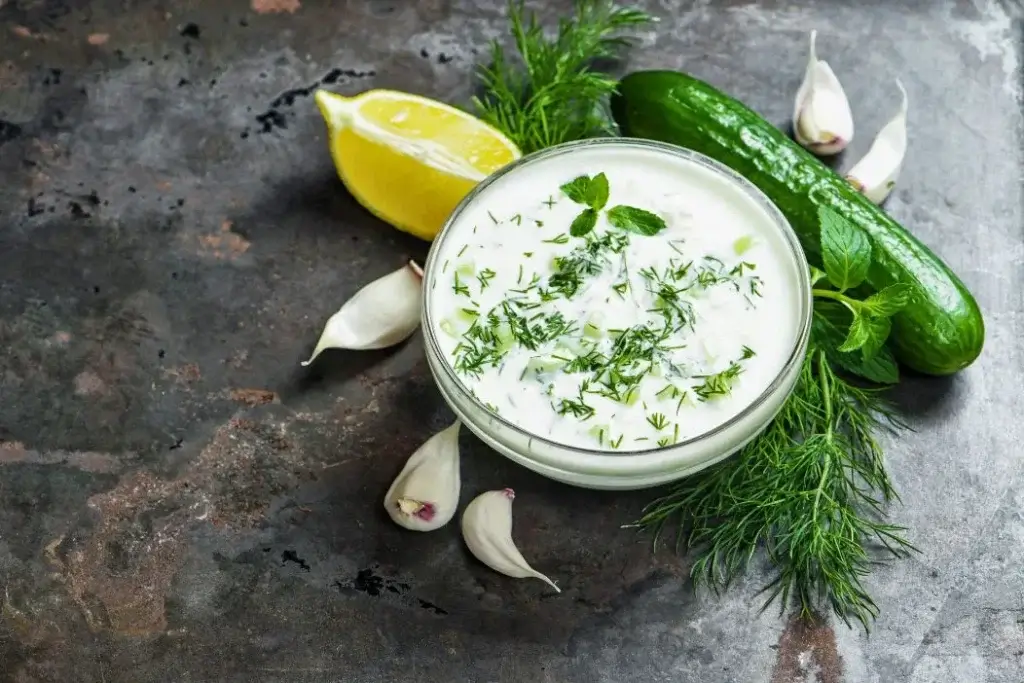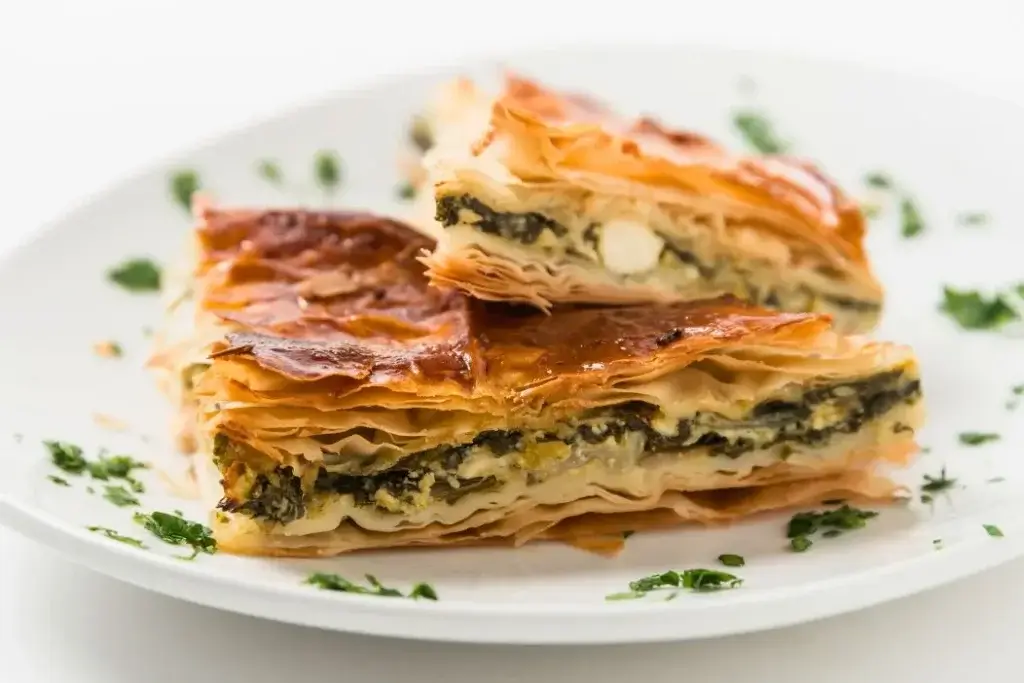If you’re planning a trip to Greece, you’ve got to indulge in the local cuisine. From savory souvlaki to creamy tzatziki, there’s a world of traditional Greek flavors waiting for you.
Get ready to tantalize your taste buds with these 15 must-try dishes that embody the essence of Greek culinary culture.
So, pack your appetite and get ready to savor the best of Greece’s delectable food scene.
Table of Contents
Souvlaki:

When in Greece, you should definitely try souvlaki, a popular street food consisting of grilled skewered meat, typically served with pita, tomatoes, onions, and tzatziki sauce.
The aroma of sizzling grilled meat wafts through the air as you wander the bustling streets, drawing you in with its irresistible allure. This quintessential Greek street food captures the essence of traditional flavors and is a must-try for any visitor.
The succulent, tender pieces of meat, often marinated in a blend of herbs and spices, are threaded onto skewers and expertly grilled to perfection. The simplicity of the dish allows the quality of the ingredients to shine through, creating a mouthwatering experience that embodies the heart and soul of Greek cuisine.
Don’t miss out on this delicious culinary delight during your Greek adventure.
Moussaka:

You can savor the rich layers of eggplant, minced meat, and creamy béchamel sauce in a traditional Greek moussaka. This iconic dish embodies traditional flavors and cooking techniques that have been passed down through generations. The key to a mouthwatering moussaka lies in the careful layering of ingredients and the slow cooking process, allowing the flavors to meld together perfectly. The eggplants are typically sliced, salted, and then fried to achieve a tender and flavorful base. The minced meat is cooked with aromatic spices like cinnamon and nutmeg, adding depth to the dish. Finally, a velvety béchamel sauce is poured over the layers before baking to golden perfection. Here’s a glimpse of the key ingredients used in moussaka:
| Ingredients | Cooking Techniques | Traditional Flavors |
|---|---|---|
| Eggplant | Sliced and fried | Earthy |
| Minced Meat | Slow-cooked with spices | Aromatic |
| Béchamel Sauce | Pouring and baking | Creamy |
Tzatziki:

You’ve got to try tzatziki when you’re in Greece.
This refreshing yogurt cucumber dip is perfect with grilled meats.
It’s a classic Greek dish that you won’t want to miss out on!
Refreshing Yogurt Cucumber Dip:
Once you have gathered all the necessary ingredients, start by finely grating the cucumber for the refreshing yogurt cucumber dip (tzatziki). This traditional Greek dip is a delightful blend of yogurt, cucumber, garlic, and olive oil, making it a perfect accompaniment to a variety of dishes. Here’s a simple recipe to prepare this delicious dip:
| Ingredients | Instructions |
|---|---|
| 1 cucumber | Finely grate the cucumber |
| 1 1/2 cups yogurt | Combine with grated cucumber |
| 2-3 garlic cloves | Crush and mix in with yogurt and cucumber |
| 2 tbsp olive oil | Drizzle over the mixture and stir |
| Salt and pepper | Add to taste |
| Fresh dill | Optional, for garnish |
This versatile dip can also be customized with variations such as adding mint or lemon zest for a refreshing twist. If you’re looking for cucumber dip alternatives, consider recipes like Indian raita or Middle Eastern labneh.
Perfect With Grilled Meats:
To truly savor the traditional Greek experience, pair your grilled meats with the refreshing yogurt cucumber dip, tzatziki, which complements the flavors with its delightful blend of yogurt, cucumber, garlic, and olive oil.
The creamy texture of tzatziki perfectly complements the smoky, savory flavors of grilled meats, creating a harmonious balance on your palate. This classic Mediterranean condiment not only adds a refreshing touch to your meal but also enhances the overall dining experience.
When enjoying grilled meat pairings with tzatziki, you’ll find that the traditional Greek sides and accompaniments elevate the meal to a whole new level.
Spanakopita:

When in Greece, make sure to sample the delicious spanakopita, a savory pastry filled with spinach and feta cheese. This traditional Greek spinach pie is a must-try, and you can find it in most bakeries or local restaurants.
If you want to try making it at home, look for the best spanakopita recipes that include tips for the perfect flaky pastry and flavorful filling. Spanakopita variations abound, from individual hand-sized pastries to large family-sized pies.
The spanakopita’s nutritional value is noteworthy, as it’s packed with nutrients from the spinach and feta cheese. When making homemade spanakopita, consider experimenting with different spanakopita filling ideas to customize it to your taste.
Whether you enjoy spanakopita with feta cheese or prefer other variations, mastering the art of crafting the perfect spanakopita pastry is key to a delicious outcome.
Gyro:

You can’t visit Greece without trying a gyro, a popular street food that offers a satisfying blend of flavors and textures. Gyros are made with meat, typically chicken, or lamb, cooked on a vertical rotisserie. It’s then wrapped in a warm pita and topped with tomatoes, onions, and tzatziki sauce. The dish has variations across Greece, with regional differences in the choice of meat and toppings. In recent years, the gyro’s global popularity has given rise to fusion cuisine trends, resulting in innovative variations such as gyro burritos, sushi, and salads. This evolution showcases the adaptability of this beloved Greek dish to different culinary traditions, making it a must-try for food enthusiasts worldwide.
| Gyro Variations | Regional Differences | Fusion Cuisine Trends |
|---|---|---|
| Chicken, or Lamb | Varied toppings and sauces | Gyro burritos, sushi, and salads |
Baklava:

You’ve got to try baklava when in Greece.
Its sweet flakiness and rich history will captivate your taste buds and curiosity.
Let’s explore why this iconic Greek dessert is a must-try on your culinary adventure.
Baklava’s Sweet Flakiness:
Indulge in the sweet, flaky layers of baklava, a delightful pastry that will captivate your taste buds with its rich blend of nuts, honey, and delicate phyllo dough.
Baklava’s origin can be traced back to the Ottoman Empire, but it has become an integral part of Greek cuisine. The dessert has evolved over centuries and has various regional variations, with each area adding its own unique touch.
For instance, in northern Greece, baklava is often made with a spicier mix of nuts, while in the southern part of the country, it tends to be sweeter with more extensive use of honey.
Regardless of the variation, the sweet flakiness of baklava remains consistent, making it a must-try treat during your visit to Greece.
Baklava’s Rich History:
When visiting Greece, it’s important to understand the rich history behind baklava, which can be traced back to the Ottoman Empire. This delectable pastry has evolved over time, leading to various regional variations in Greece and neighboring countries.
Each region has its own unique twist, whether it’s the use of different nuts, spices, or syrups. Baklava holds great significance in Greek celebrations and traditions. It’s a staple dessert during festive occasions such as weddings, religious holidays, and family gatherings.
The intricate layers of phyllo dough, nuts, and honey syrup symbolize the layers of history and culture that have shaped Greece over the centuries. Trying baklava in Greece isn’t just about savoring its sweet flakiness but also experiencing a taste deeply rooted in the country’s heritage.
Fasolada:

Experience the heartiness of Fasolada, a staple in Greek cuisine that embodies simplicity and robust flavors. This traditional Greek soup offers a delightful array of culinary experiences.
When in Greece, you must try Fasolada for these reasons:
- Vegetarian options in Greece: Fasolada is a perfect choice for vegetarians, as it’s a hearty bean soup that’s both delicious and filling.
- Regional variations of Fasolada: Different regions in Greece have their own unique spin on Fasolada, incorporating local ingredients and cooking techniques that add diversity to the dish.
- Nutritious ingredients: Fasolada is packed with nutritious ingredients like beans, tomatoes, onions, and a variety of herbs, making it a wholesome and satisfying meal.
- Cultural significance: This dish has a rich history and cultural significance in Greece, reflecting the country’s agricultural traditions and deep connection to simple, flavorful foods.
Dolmades:

You’ve got to try Dolmades when you’re in Greece.
These Greek stuffed grape leaves are a popular appetizer and a must-try traditional dish.
The flavorful combination of rice, herbs, and sometimes ground meat wrapped in grape leaves will surely tantalize your taste buds.
Dolmades: Greek Stuffed Grape Leaves
If you’re visiting Greece, you must try the traditional Greek dish, Dolmades, which consists of grape leaves stuffed with a flavorful mixture of rice, herbs, and sometimes meat. When it comes to dolmades, there are a few things you should know:
- Stuffed grape leaves are meticulously prepared by wrapping the filling in brined grape leaves, resulting in a unique texture and taste.
- The cooking techniques involve delicate rolling and simmering, ensuring that the grape leaves become tender and infused with the savory flavors of the filling.
- Vegetarian options are widely available, with many establishments offering dolmades filled exclusively with a delectable blend of rice, pine nuts, and aromatic herbs.
- These delectable morsels are often served as an appetizer or part of a mezze platter, providing a delightful burst of Mediterranean flavors.
Dolmades: Popular Greek Appetizer
When in Greece, indulge in the popular Greek appetizer Dolmades for a flavorful taste of traditional Greek cuisine. Dolmades, made from a traditional recipe, consist of grape leaves stuffed with a delicious mixture of rice, pine nuts, and aromatic herbs. This appetizer is then gently cooked to perfection, resulting in a delectable dish that perfectly encapsulates the essence of Greek flavors.
What makes Dolmades even more intriguing is the variations and regional differences found across Greece. In some regions, you may find Dolmades stuffed with meat or a combination of rice and meat, adding a different layer of richness to the dish. Each variation offers a unique twist, showcasing the diverse culinary heritage of Greece.
Don’t miss the opportunity to savor these delightful appetizers during your Greek culinary adventure.
Pastitsio:

Where can you find the best pastitsio in Greece? Look no further than the local tavernas and family-owned restaurants, where generations have perfected this classic Greek dish. Here are a few things you should know about pastitsio:
- Traditional recipe variations: Different regions of Greece have their own take on pastitsio, with variations in the type of pasta, meat, and spices used.
- Cultural significance and history: Pastitsio has been a beloved dish in Greek cuisine for centuries, with its layers of pasta, savory meat sauce, and creamy béchamel sauce symbolizing the rich and diverse culinary heritage of Greece.
- Comfort food favorite: This hearty casserole is a staple at family gatherings and celebrations, offering a comforting and satisfying meal for all to enjoy.
Octopus:

You’ll be fascinated to learn about the traditional methods of tenderizing octopus for cooking in Greece.
The popular octopus dishes in Greece are a must-try, offering a unique and delightful taste of Greek cuisine.
Understanding the cultural significance of octopus in Greek food will give you a deeper appreciation for this beloved seafood.
Tenderizing Octopus for Cooking:
To tenderize octopus for cooking, here are some techniques you can use:
- Start by pounding the octopus with a meat mallet to break down its tough fibers.
- Submerge the octopus in a pot of water to help tenderize it.
- Freeze the octopus before cooking to further break down its tough texture.
- Consider pressure-cooking the octopus for a quicker and more effective tenderization process.
- Utilize traditional Greek methods such as beating the octopus against rocks or drying it in the sun for a few hours.
These tenderizing techniques are essential for ensuring that the octopus becomes tender and flavorful when cooked. By following these methods, you can prepare the octopus for delicious traditional Greek dishes and enhance its natural flavors with suitable pairings.
Popular Octopus Dishes in Greece:
When in Greece, you can savor the tender and flavorful octopus in popular dishes such as grilled octopus, octopus stifado, and octopus souvlaki.
Greeks have mastered the art of preparing octopus, using traditional methods to bring out its best flavors. One of the tenderizing techniques involves beating the octopus against rocks to break down its muscle fibers, ensuring a more delicate texture.
Grilled octopus, a beloved dish, is often marinated in olive oil, lemon juice, and oregano before being charred to perfection.
Octopus souvlaki offers a delightful street food experience, featuring skewered and grilled octopus, served with pita bread and tangy tzatziki.
These dishes truly highlight the traditional preparation methods and culinary expertise of Greece.
Cultural Significance of Octopus:
The cultural significance of the octopus in Greece extends beyond its culinary use, with the octopus having deep roots in Greek folklore and traditions.
When in Greece, you’ll find that octopus holds a special place in cultural traditions, often being featured in celebratory meals and festivities.
Greek customs and regional variations influence the cooking techniques used for octopus, showcasing the diversity of preparation methods across different parts of the country.
The use of Mediterranean ingredients in octopus dishes reflects the rich culinary heritage of Greece, highlighting the importance of fresh and locally sourced seafood delicacies in Greek cuisine.
Whether grilled, stewed, or marinated, the octopus embodies a connection to the sea and a celebration of coastal life, making it an integral part of Greek gastronomy.
Loukoumades:

When visiting Greece, you must indulge in the delectable loukoumades, a beloved traditional Greek dessert.
Loukoumades are fluffy, bite-sized dough balls deep-fried to golden perfection, then drizzled with honey and sprinkled with cinnamon or sesame seeds. Variations of loukoumades can include toppings like chocolate sauce, crushed nuts, or even ice cream, adding a modern twist to this classic treat.
Additionally, Greece hosts numerous loukoumades festivals where locals and tourists alike gather to savor these sweet delights. During these festivals, you can experience the vibrant traditions of making and serving loukoumades, often accompanied by live music, dancing, and a joyful atmosphere.
Whether you prefer the traditional honey and cinnamon or the innovative toppings, indulging in loukoumades is an essential part of the Greek culinary experience.
Saganaki:

Indulge in the irresistible saganaki, a must-try traditional Greek appetizer, during your visit to Greece. This iconic dish features sizzling cheese, typically kefalotyri, that’s fried to perfection.
Here are some cooking tips and a simple Saganaki recipe to recreate this delectable dish at home:
- Use a non-stick pan to prevent the cheese from sticking.
- Coat the cheese in flour before frying to create a crispy exterior.
- Squeeze fresh lemon juice over the saganaki right before serving for a burst of citrus flavor.
- Sprinkle with a pinch of dried oregano for an authentic Greek touch.
To make saganaki at home, simply slice the cheese, dip it in flour, and pan-fry until golden brown. Serve immediately and enjoy the gooey, savory goodness of this classic Greek appetizer.
Greek Salad:

Where can you find the best traditional Greek salad in Greece?
Greek salad, known as horiatiki, is a staple dish with regional variations. This classic salad typically includes tomatoes, cucumbers, bell peppers, onions, feta cheese, Kalamata olives, and oregano, drizzled with olive oil. Not only is it a flavorful dish, but it also offers numerous health benefits due to its fresh and nutrient-rich ingredients. The combination of vegetables and olive oil provides essential nutrients and antioxidants.
Galaktoboureko:

You can find Galaktoboureko, a traditional Greek dessert made with layers of phyllo pastry and creamy custard, in most Greek bakeries and restaurants. When in Greece, make sure to try this delectable treat. Here are some key points to consider:
- Traditional dessert: Galaktoboureko is a beloved traditional dessert that has been enjoyed in Greece for generations.
- Greek pastry: The flaky layers of phyllo pastry combined with the smooth custard filling make it a delightful Greek pastry.
- Best places to try galaktoboureko: Head to local bakeries or traditional Greek tavernas to savor the best versions of galaktoboureko.
- Alternative galaktoboureko recipes: Some regions may have their own variations, so don’t hesitate to explore different recipes to experience the diverse flavors of galaktoboureko.
Yemista:

Exploring the traditional Greek dish Yemista involves savoring a flavorful combination of stuffed vegetables. This beloved dish is a staple of Greek cuisine, offering a delightful array of vegetarian options. Yemista, which translates to “stuffed” in Greek, typically consists of tomatoes, bell peppers, zucchinis, or eggplants filled with a hearty mixture of rice, onions, and aromatic herbs. The vegetables are then baked to perfection, allowing the flavors to meld together, creating a mouthwatering experience. Below is a table highlighting the key elements of Yemista:
| Stuffed Vegetables | Traditional | Greek Cuisine |
|---|---|---|
| Vegetarian Options | Flavorful | Satisfying |
Yemista is a must-try for anyone looking to savor the essence of traditional Greek cooking while indulging in a wholesome, vegetarian meal.
Frequently Asked Questions:
Are There Any Specific Regions in Greece Known for Their Unique Variations of These Traditional Foods?
In Greece, specific regions are known for unique variations of traditional dishes. These regional specialties hold cultural significance and historical ingredients. Pronunciation tips, traditional drinks, food pairings, dining customs, and local etiquette add to the experience.
Can You Provide Tips on How to Properly Pronounce the Names of These Dishes When Ordering in a Greek Restaurant?
When ordering in a Greek restaurant, use a pronunciation guide to say the names of traditional dishes properly. It’s essential for navigating Greek cuisine. Language tips for food ordering will enhance your dining experience.
Are There Any Cultural or Historical Significance Behind the Ingredients Used in These Traditional Greek Foods?
When ordering in a Greek restaurant, it’s important to understand the cultural significance and historical importance of the ingredients used in traditional Greek foods. This knowledge adds depth to your dining experience and appreciation for the cuisine.
Are There Any Traditional Greek Drinks or Beverages That Pair Well With These Dishes?
You should try traditional Greek drinks that pair well with these dishes. Local drink specialties like ouzo and tsipouro are popular choices. Greek beverage culture emphasizes enjoying drinks that complement the flavors of the food.
Are There Any Specific Customs or Etiquette to Keep in Mind When Enjoying These Traditional Greek Foods in a Local Setting?
When dining locally in Greece, it’s important to respect traditional customs. Proper table manners include keeping your hands on the table, avoiding loud chewing, and not resting your elbows. Embrace the local dining experience!
Conclusion:
In conclusion, Greek cuisine offers an array of flavors that are as rich in taste as they are in cultural significance. Each of the 15 traditional Greek dishes highlighted in this article is a piece of Greece’s storied culinary heritage, waiting to be experienced. From the sizzling zest of gyro to the honeyed layers of baklava, these essential tastes are a must-try for anyone looking to dive into the heart of Greek flavors.
Whether you’re strolling through the vibrant streets of Athens or cooking in your own kitchen, don’t miss out on these mouthwatering delights. They’re not just meals; they’re an invitation to indulge in a legacy of delectable tradition that’s central to the Greek way of life.


